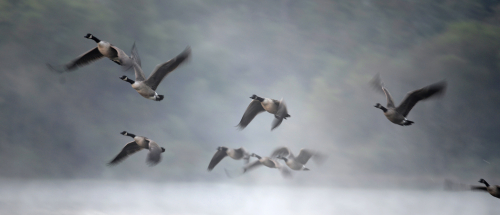BY KIERAN LINDSEY, PhD
This year’s class of Canada geese (Branta canadensis) naval aviators have started flight school!
I’ve been watching these youngsters on daily dog-walks in the park since early May. When they first showed up I noticed their resemblance, in size and coloration, to the yellow puffball flowers of the American sycamores (Platanus occidentalis) towering above. There were quite a few adults living in and around the lake and several pairs successfully hatched large clutches, the second batch about 10 days after the first. The whole flock pitched in to keep the cautious but curious brood within a protective circle, long black necks and heads swiveling like periscopes scanning the horizon for imminent threats.

Every morning’s stroll included a peek into the classroom, watching as the new recruits moved through basic training. First lesson: water = safety. Mandatory swimming lessons for all sailors! Initially, members of the new crew were skeptical, needing some strongly worded encouragement from a drill instructor to take the plunge.

In no time at all, though, they had their sea-legs and formed a flotilla.

Next, the unit practiced how to parade. The slow, unhurried pace set by the adults was clearly intended to convey respectability and prestige, and they pulled it off with stately ease. The trainees were another story entirely. Try as they might to imitate their elders, casual dignity is mighty difficult to achieve when your growing body hasn’t quite caught up to your oversized feet—ask any 12 year old boy wearing size 11 sneakers. The slightest break in concentration and the whole company piled up like dominoes.

There was so much to learn! How to keep their uniforms squared away…

…calisthenics to strengthen those important pectoral muscles…

…choosing the right mess hall…

…not to mention growing by leaps and bounds. Before long, it was time to strap on the black aviator helmet and take off!

Their first flights were brief and aquatic; buoyant new pilots seem to find over-water touch-and-go’s less intimidating. What’s the worse that can happen? You ditch, you get wet. A bruised ego heals a lot faster than broken bones.

Next, the flight instructors lead youngsters on low, circular cruises around the park, honking encouragement all along the way. Landing on turf requires more skill and daring…

… as well as greater maneuverability to avoid trees, lamp posts, power lines, and buildings. Practice makes perfect but there can be some embarrassing mistakes along the way. One missed turn can result in an unintended landing strip.

Still, they’ve definitely got the right stuff: determination, focus, and drive. Whether they choose to become full-time Midwesterners or set off next year for northern climes, to search for adventure and a mate, wild blue yonder here they come!


